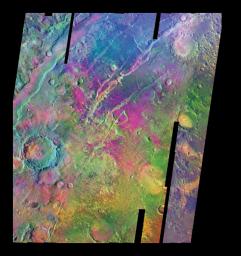
|
Olivine-Rich Bedrock Around Nili Fossae
- Click the image above for a larger view
- Full-Res JPEG (2400 x 2550) (971.5 kB)
- Full-Res TIFF (2400 x 2550) (18.4 MB)
Caption:
Colors indicate infrared emission signatures in this mosaic of images from NASA's Mars Odyssey orbiter of a region of martian troughs named Nili Fossae. Analysis of this information from Odyssey's Thermal Emission Imaging System suggests that a deposit rich in the mineral olivine is about four times larger than indicated in earlier data from a lower-resolution infrared instrument on NASA's Mars Global Surveyor. The olivine-rich exposures appear magenta to purple-blue in this color-coding.
Olivine can turn into other minerals rapidly in the presence of water. This deposit, in a relatively old region of Mars' surface adjacent to one of the planet's largest volcanoes, Syrtis Major, suggests the region may never have seen much water.
The mosaic covers most of an area about 380 kilometers (about 240 miles) wide, from 75 degrees to 81 degrees in east longitude and from 18 degrees to 25 degrees in north latitude. North is up. Emission intensities at infrared wavelengths of 12.57 microns, 11.04 microns and 9.35 microns are displayed in red, green and blue, respectively.
Background Info:
This mosaic was presented in a report in the June 2005 issue of the journal Geology . For additional information about that report, see a University of Hawaii press release http://www.soest.hawaii.edu/SOEST_News/News/PressReleases/Hamilton/ .
Cataloging Keywords:
| Name | Value | Additional Values |
|---|---|---|
| Target | Mars | |
| System | ||
| Target Type | Planet | |
| Mission | 2001 Mars Odyssey | Mars Global Surveyor (MGS) |
| Instrument Host | Mars Odyssey | Mars Global Surveyor |
| Host Type | Orbiter | |
| Instrument | Thermal Emission Imaging System (THEMIS) | |
| Detector | ||
| Extra Keywords | Color, Infrared, Thermal, Volcano, Water | |
| Acquisition Date | ||
| Release Date | 2005-06-02 | |
| Date in Caption | ||
| Image Credit | NASA/JPL/ASU | |
| Source | photojournal.jpl.nasa.gov/catalog/PIA07993 | |
| Identifier | PIA07993 | |
